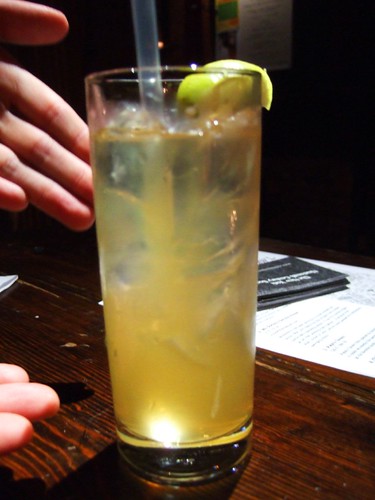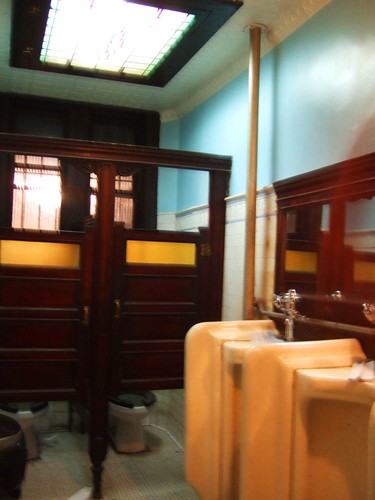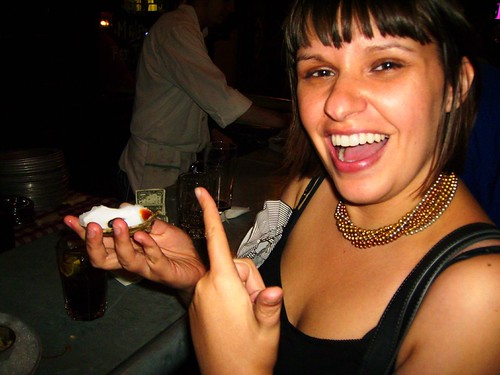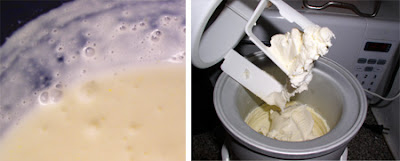 Downing the Original 1864 House Ale at Pete’s Tavern. Photo by Ilana Kohn.
Downing the Original 1864 House Ale at Pete’s Tavern. Photo by Ilana Kohn.
I am pleased to report that the 19th Century Pub Crawl was a rousing success! Over forty people turned out and we covered five bars, from E 4th st. to E 55th. A small group even made it all the way to PJ Clark’s.
We were a motley crew, all ages and backgrounds, brought together by our mutual love of history. Additionally, there were some impressively costumed ladies sporting full 19th century garb, corsets and all. A couple fine gals even came straight from their jobs as historic interpreters at Old Bethpage Village. I don’t think a more convivial group could be found anywhere on the streets of New York that night.
We began our crawl at Swift, a modern bar whose decor and cocktail menu are inspired by the writings of Jonathon Swift. I tried one the bar’s original cocktails, the Captain Gulliver, a combination of Jameson, Ginger beer, and lemon. I had wanted to try the ginger beer, which is so 19th century, but it was non-alcoholic. This cocktail was the perfect solution.
of Jameson, Ginger beer, and lemon. I had wanted to try the ginger beer, which is so 19th century, but it was non-alcoholic. This cocktail was the perfect solution.
Left: The Captain Gulliver
Next I led the group to McSorely’s, who have been serving their light and dark house brew since their establishment in 1854. The light beer allegedly tastes like cream soda. I ended up not going in: McSorely’s is a cornerstone of drinking at NYU, so the bar was already packed by the time we arrived at 6:30. Half of the crawl decided to stop in, and met up with us later, while the rest of us continued to our third stop, Pete’s Tavern.
Pete’s is also known for the house brew they have served up since 1864. It looks like a dark beer, but tastes like Miller Light. This beer marked a definite turn in my sobriety and in the sobriety of my cohorts.
The interior was beautiful, the bartender gracious, and the staff incredibly tolerant of our drunken antics. I’d stop in Pete’s any day.

Next, we headed down the street to nearby Old Town Bar. At this point, we were famished, so several of us gorged ourselves on the bar’s delicious burgers and fries. I also sent my friend Marc to gather reconnaissance in the men’s bathroom. The marble urinals, “made by Hinsdale in 1910,” are impressive enough that Old Town mentions them on their website. The tavern’s dumbwaiter is also the oldest one operating in the city, and pretty cool to see in action.
Right: The infamous urinals. Overall, a beautiful bathroom.
Lastly, we grabbed a cab and headed uptown to our final destination: PJ Clark’s. After gorging ourselves (again) on a plate of onions rings so crispy they taste like green bean casserole, I noticed that they had an oyster bar. I was thrilled. “How Victorian!” I squealed. In every period source and novel I have read, haughty men are slurping down bivalves by the plateful.
I’d never had an oyster before, so I ordered one for myself and one for Marc. To be honest, I was expecting something squishy and revolting, and misery loves company. We loaded up with condiments and sucked them down, and were surprisingly not disgusted. They just tasted like salt. Or maybe I was wasted.
My evening ended by climbing into a cab bound for Queens. Upon arriving home, I left a trail of my clothing and personal items from my front door to my bed, where I promptly passed out. The next morning, I felt as though I had been struck by a moving carriage. If this were the 19th century, I’d be one step away from McGurk’s.
To see more photos from the event, swing by our group on Flickr here. And if you’re a Flickr member, and attended the event, feel free to add your own photos to our group pool.
We’re already planning another crawl this spring, following the bars on Manhattan’s west side that formerly served the harbor’s sailors, seamen, and other rugged sorts. And is New York the only city where a woman can wear an 1860’s dress with punk-red hair and not be looked at twice? We’re going to find out, because we’re bringing the Crawl to Boston. Stay tuned for more news.



.jpg)


